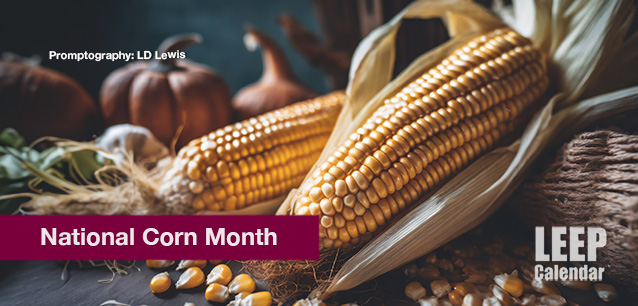 AD
AD
Today is: November 05
Scroll to explore events active on this date.
LEEP INK FEATURES

August? Absolutely!
In August, we live through the Dog Days of Summer. It's hot and often humid, and those who can leave for better climates do. Down south, winter is in full force. August is also known as "the ...

In The Heat of July: July 2025 Events
Is it hot enough (or cold enough if you're below the equator) for you yet? There is actually a day for that! Like every month, I pick a diverse collection of events you may or may not know about. This ...

May Blooms: Events in May 2025
Along with October, May is one of the most densely packed months of the year. It's before the summer humidity and the last whole month of the school year. The weather is warming in t...
About Corn Month
Retail , United States
Ends: Oct 31, 2025
DESCRIPTION:
Corn, also known as maize, has a storied history that begins in ancient Mesoamerica and was first domesticated in Mexico around 9,000 years ago. Indigenous peoples cultivated corn from a wild grass called teosinte, and through selective breeding, they developed the staple crop known today, which would become integral to the agricultural societies of the Americas.
AS A FOOD
As European explorers reached the Americas, corn reached the rest of the world, where it adapted to various climates and soils, becoming a global commodity. Today, it is not only a vital food source but also a key ingredient in animal feed and a raw material in industry.
Corn can be cooked in numerous ways, reflecting its versatility. It can be boiled, grilled, roasted, and steamed when on the cob. Corn kernels can be cooked similarly to other grains or popped for popcorn. Moreover, corn is ground into flour or meal and used in popular recipes.
Some of the most common dishes that feature corn include:
TORTILLAS—A cornerstone of Mexican cuisine, tortillas are flatbreads made from cornmeal, essential for tacos and many other traditional dishes.
POLENTA—In Italian cooking, polenta is a porridge made from cornmeal, often served as a side or with toppings like cheese, sauce, or vegetables.
CORNBREAD—A staple in the Southern United States, cornbread is a quick bread made with cornmeal, often enjoyed with barbecues and as a comfort food.
CORN CHOWDER—A hearty soup popular in the American Northeast, corn chowder includes corn kernels, potatoes, cream, and sometimes bacon or ham.
AREPA—In South American countries like Colombia and Venezuela, arepas are thick patties made from precooked corn flour, often filled with cheese, meats, or other fillings.
PAP—A traditional cornmeal porridge served with meat and vegetable stews in various African countries.
AS AN ALTERNATIVE FUEL
Corn features in the production of biofuel, specifically ethanol. Corn-based ethanol is a renewable fuel made from the fermented starch of corn grains. It is blended with gasoline to increase octane levels and improve emissions quality. Corn ethanol is the most common biofuel in the United States, and government mandates and subsidies have supported its production.
The use of corn for ethanol production has been a subject of debate due to concerns about its impact on food prices and food supply, as well as discussions about the net energy and environmental benefits of corn-based ethanol compared to other fuels. Despite this, it remains a significant component of biofuel production in many countries.
National Corn Month is an opportunity to explore the culinary delights of this universal grain or chip in for a greener planet by upgrading your fuel.
VIDEOS
SUPPORTING DOCUMENTS
Currently, this event does not have supporting documents.
ADDITIONAL IMAGES
Currently, this event does not have supporting images.
Where would you like to go now?
 AD
AD


/footer-logo.svg)
